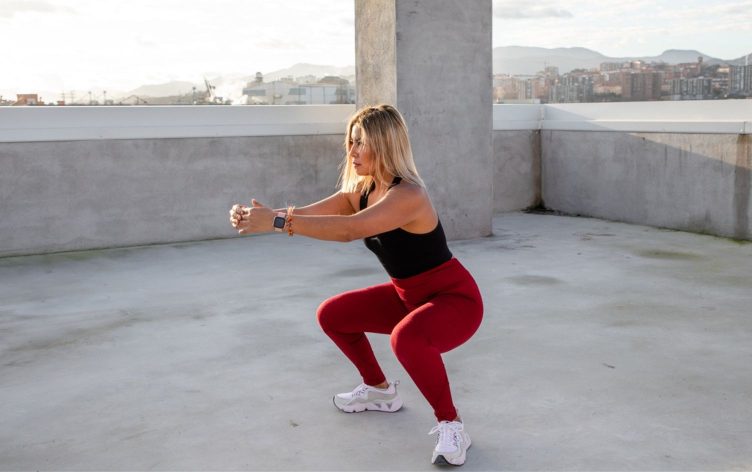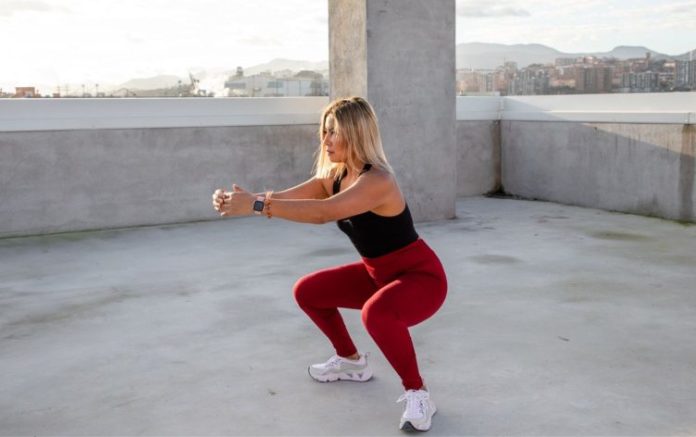
Bodyweight workouts are convenient and effective, particularly if you’re working out at home or outdoors without access to equipment. But as you get fitter, your body adapts and gets better at the exercises you’re doing. When you have access to a variety of fitness equipment, increasing the difficulty to continue challenging yourself is as simple as adding more weight. But how do you get the same effect for bodyweight exercises?
One fairly intuitive option is to increase your workout volume by adding repetitions to each set, or increase the number of sets you do. Another tried-and-true strategy is to decrease the amount of rest you take, so you have less time to recover. But if you’ve already tried those methods and are craving variety, here’s how fitness pros recommend upping the intensity.
1
USE ISOMETRICS
Isometric exercises involve holding a static position for a set period of time. Most often, we think of planks and wall sits as classic isometric exercises, but the truth is, you can add an isometric element to any exercise to make it more difficult. “Perform several repetitions of a movement, and as you begin to feel the first hint of fatigue, hold the movement in the mid-range of motion for 10–30 seconds,” recommends Rocky Snyder, a certified strength and conditioning specialist. For example, you could hold a half-squat after doing a set of air-squats or hold at the halfway point of an inverted row.
2
INCREASE THE RANGE OF MOTION
Another way to make a bodyweight exercise harder is to increase how far your body has to travel to complete the exercise. Increase the range of motion, for example, by elevating your front foot in lunges or split squats or doing chest-to-floor pushups with your hands on blocks. This increases the difficulty, says Tim Liu, a certified strength and conditioning coach. “It recruits more muscle fibers, places them under more stress, and allows you to build strength and stability.”
3
CHANGE THE ANGLE
Similarly, adjusting your body positioning can change how much of your bodyweight a given muscle is responsible for moving during an exercise, explains K. Aleisha Fetters, an online trainer and author of “Fitness Hacks for Over 50.” “For example, if you’ve been doing traditional pushups, you can increase the load on your chest by performing your reps with your feet elevated on a chair behind you. If you’ve been doing inverted rows, try performing them from a lower anchor point so that your body is closer to parallel with the floor.”
4
USE COMPOUND SETS
Exercises that work opposing muscle groups are often paired together in traditional strength training supersets to create balance and avoid muscle fatigue. For example, you might perform biceps curls and triceps extensions in a superset.
But for bodyweight-only workouts, a different approach can help increase difficulty. “I love to train people in compound sets because they’re a great way to get a burn faster and make a workout more efficient,” says Colin Laughlin, a certified strength and conditioning specialist. “A compound set is when you combine two exercises back-to-back that work the same muscle group. For example doing squats and then immediately transitioning into lunges.”
5
TRY 1.5 REPS
Another way to change range of motion is by adding a half-repetition between full repetitions of an exercise. “A 1.5 squat would be starting standing, then flexing the hips and knees to 90
degrees, going up halfway, dropping back to 90 degrees, and then going all the way back to standing position,” says Michelle Diaz, a certified personal trainer and health coach for new moms and pregnant women. Adding half-repetitions is a simple way to increase time under tension or the amount of time your muscles are being asked to work.
6
ADD A DEAD STOP
In contrast to adding an isometric hold to an exercise, a dead stop means stopping directly in the middle of an exercise. “Adding a full, extended pause between the eccentric and concentric phase of any exercise eliminates the possibility of your muscles’ elastic properties contributing to the next phase of the exercise,” Fetters explains. “For example, in bodyweight squats, when you reach the bottom of the squat, don’t just briefly pause there; hang out there for a good two seconds and then raise back up. You will work your legs so much harder, and it won’t add time to your workout. If anything, it might fatigue you faster.” Another great option: hand-release pushups, where you lower all the way to the ground, take your hands off the ground, then press yourself back up to the top of your pushup.
7
ADD EXPLOSIVENESS
Introducing a plyometric element can take things up a notch very quickly. “For squats this would be adding a jump or for pushups, this would be driving your body up from the ground faster,” Laughlin explains. “This works to add intensity because it forces your body to utilize its fast-twitch muscle fibers, which have higher metabolic rates.” An important caution, though: “This strategy is not for everyone. Anyone with joint issues [should] avoid this strategy unless they are [working] with a certified professional.”
8
ENGAGE YOUR CORE
“Every exercise is infinitely harder and more effective with proper core positioning,” Fetters points out. “But when most people ‘brace their core,’ they really just bear down like they are trying to poop. Instead, think about tucking your tailbone so that your ribs point straight down to your feet and not out in front of you. You’ll feel some slight core engagement. Then, once you get moving, squatting, hinging, pushing, pulling, you’ll feel that maintaining that position at all times is super challenging.”
9
UTILIZE 21S
This is another way to play with range of motion, Diaz says. “It’s also great for increasing the production of lactic acid in order to get a good burn and makes any exercise way harder.”
Completing 21s means performing an exercise in three ranges of motion for 7 reps in each, adding up to a total of 21 reps: The bottom half, the top half and full range. So for example, with a pushup you’d do 7 reps from the bottom to halfway up, 7 reps from halfway up to arms fully extended and 7 full pushups.
10
DECREASE STABILITY
“When we put ourselves off balance, we recruit more stabilizer muscles to complete an exercise,” says Shannon Mullen, a personal trainer and fitness consultant for FitRated.com. “This requires us to use more core strength and helps us develop more strength in less time.”
There are a few ways you can get this effect at home. You can try decreasing your base of support, like putting your feet closer together for squats and lunges or lifting one leg for pushups, deadlifts and planks, Mullen says. “For even more of a challenge, you can also move from bilateral to unilateral movements, such as doing single-leg squats, single-leg hip-bridges or single-arm pushups.
Lastly, you can decrease the stability of the surface. “You can try standing on a folded or rolled up towel as you complete single-leg squats. To make pushups and planks harder, you can put your hands or feet on a basketball or a couch cushion.”







